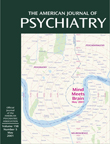Drs. Palmer and Jeste Reply
To the Editor: We thank Drs. Spivak and Epstein for their letter. They propose that Newton’s psychosis reflected the effects of metal poisoning. Several biographers of Newton considered but rejected this possibility because it was not supported by available evidence (Christianson, 1984; 1). Tremor is a frequent symptom of such poisoning, yet none was apparent in any of Newton’s handwritten documents from that period (1). Another frequent symptom of mercury poisoning is a loosening of the teeth. However, as Christianson (1984) noted, “Newton died, at the age of eighty-four, with all of his secondary teeth but one, rather remarkable for a man of his day” (p. 359). None of the documents from Newton (or the observations by his acquaintances) mention any of the physical symptoms frequently associated with metal poisoning, such as uremia, jaundice, emaciation, darkened nails, premature aging, weight loss, lethargy, visual disturbances, convulsions, coma, or paralysis (1).
The timing of Newton’s “episode,” which seems to have been limited to a circumscribed period of 18 months between 1692 and 1693 (at most) also does not fit the metal-poisoning hypothesis, since his experiments in alchemy (and exposure to mercury and other metals) preceded and continued well beyond this period. As Christianson (1984) commented, “Should there not have been additional breakdowns, given his prolonged addiction to the fire and the crucible?” (p. 360). Although Newton’s greatest contributions were developed during a relatively short period of his career, he is hardly unique in this respect. There are numerous examples of great scientific and artistic contributions occurring early in the careers of individuals who, while productive in later years, did not quite parallel their earlier achievements. Also, although it appears true that Newton had lifelong difficulties with interpersonal skills, his contemporaries apparently saw this 1692–1693 episode as unique and different from his usual demeanor (Christianson, 1984).
As we noted in our article, it is impossible to reach a firm conclusion about etiology for a psychotic episode that occurred more than 300 years ago. However, as shown by the case presentation of the contemporary patient discussed in our article, a psychotic condition can appear in mid-to-late life that has no clear etiology, from which patients may experience a complete remission.
1. Ditchburn RW: Newton’s illness of 1692–3. Notes and Records of the Royal Society of London 1980; 35:1–16Crossref, Medline, Google Scholar



